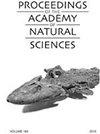巴西和玻利维亚马德拉盆地bbb10期maedrae Fowler的重新确认和重新描述(特征:岩斑科)
IF 0.5
4区 环境科学与生态学
Q4 BIODIVERSITY CONSERVATION
Proceedings of the Academy of Natural Sciences of Philadelphia
Pub Date : 2020-12-22
DOI:10.1635/053.167.0109
引用次数: 0
摘要
摘要。根据对模式和最近收集的标本的检查,Moenkhausia lepidura madeirae Fowler从中间分枝杆菌的同义词中复活,并被重新描述为有效物种。马氏Moenkhausia madeirae可以通过以下特征组合从所有同源物中诊断出来:尾鳍上有两个对称的深色斑点(每个叶上一个),一个明显的肱骨斑点,18-22条分叉的臀鳍射线,成熟的雄性在最后一条简单的和第一条分叉的肛门鳍射线上分别有两个(很少有三个)发育良好的钩。该物种分布于巴西和玻利维亚的马德拉河中上游流域。与其他在尾鳍裂片上呈现对称深色斑点的Moenkhausia物种进行了比较,即M.barbouri、M.bonita、M.dichroura和M.intermedia。本文章由计算机程序翻译,如有差异,请以英文原文为准。
Revalidation and redescription of Moenkhausia madeirae Fowler from the rio Madeira basin in Brazil and Bolivia (Characiformes: Characidae)
ABSTRACT. Based on the examination of type and recently collected specimens, Moenkhausia lepidura madeirae Fowler is resurrected from the synonymy of M. intermedia and redescribed as a valid species. Moenkhausia madeirae can be diagnosed from all congeners by the following combination of characters: presence of two symmetrical dark blotches on caudal fin (one on each lobe), a conspicuous humeral blotch, 18-22 branched anal-fin rays, and mature males with two (rarely three) well-developed hooks on the last simple and first branched anal-fin rays, respectively. The species occurs in the middle and upper rio Madeira basin in Brazil and Bolivia. Comparisons are made with the other species of Moenkhausia presenting symmetrical dark blotches on the caudal-fin lobes, i.e., M. barbouri, M. bonita, M. dichroura, and M. intermedia.
求助全文
通过发布文献求助,成功后即可免费获取论文全文。
去求助
来源期刊

Proceedings of the Academy of Natural Sciences of Philadelphia
生物多样性保护-生物多样性保护
自引率
0.00%
发文量
4
期刊介绍:
The Proceedings (ISSN 0097-3157) has been published continuously since 1841. Many volumes are still available in their original printings. Early volumes are unbound, constituting two or three issues per year. Quantities of some volumes may be limited. Early volumes may have slightly soiled cover sheets, but the text blocks are perfect.
 求助内容:
求助内容: 应助结果提醒方式:
应助结果提醒方式:


